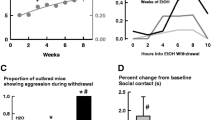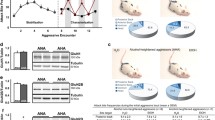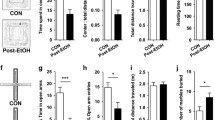Abstract
Rationale
Memantine is a potential treatment for alcoholic patients, yet few studies investigate the effect of concurrent treatment with memantine and ethanol on aggression. We evaluated aggressive behavior following ethanol consumption and treatment with glutamatergic drugs to characterize interactions between these compounds.
Objective
This study aimed to use rodent models of aggression to examine interactions between glutamatergic compounds and ethanol.
Materials and methods
Once male CFW mice reliably self-administered 1 g/kg ethanol or water, they were assessed for aggression in resident–intruder confrontations. Alternatively, aggression was evaluated following a social-instigation procedure. Animals were then injected with memantine, ketamine, neramexane, MTEP, or LY379268 before aggressive confrontations. Effects of the pharmacological manipulations on salient aggressive and non-aggressive behaviors were analyzed.
Results
Moderate doses of memantine, neramexane, and MTEP interacted with ethanol to increase the frequency of attack bites while ketamine did not. The highest dose of LY379268, an mGluR2/3 agonist, reduced both aggressive and non-aggressive behaviors after water and ethanol self-administration. Attack bites increased with social instigation and decreased with administration of high doses of MTEP and LY379268. Memantine and MTEP both reduced attack bite frequency in the instigation condition without reducing locomotor behavior.
Conclusions
Memantine and neramexane interacted with ethanol to heighten aggression. The binding characteristics of these compounds allow for ‘partial trapping’ by which some NMDARs are unblocked between depolarizations. We propose that this feature may contribute to the differential aggression-heightening interactions between these compounds and ethanol. MTEP also interacted with ethanol to escalate aggression, possibly through inhibition of mGluR5 modulation of NMDARs.



Similar content being viewed by others
References
Allgaier C (2002) Ethanol sensitivity of NMDA receptors. Neurochem Int 41:377–382
Aracava Y, Pereira EFR, Maelicke A, Albuquerque EX (2004) Memantine blocks α7* nicotinic acetylcholine receptors more potently than N-Methyl-d-aspartate receptors in rat hippocampal neurons. J Pharm Exp Ther 312(3):1195–1205
Audet MC, Goulet S, Dore FY (2009) Impaired social motivation and increased aggression in rats subchronically exposed to phencyclidine. Physiol Behav 96:394–398
Awad H, Hubert GW, Smith Y, Levey AI, Conn PJ (2000) Activation of metabotropic glutamate receptor 5 has direct excitatory effects and potentiates NMDA receptor currents in neurons of the subthalamic nucleus. J Neurosci 20:7871–7879
Bannai M, Fish EW, Faccidomo S, Miczek KA (2007) Anti-aggressive effects of agonists at 5-HT1B receptors in the dorsal raphe nucleus of mice. Psychopharmacology 193:295–304
Belozertseva IV, Bespalov AY (1999) Effects of NMDA receptor channel blockade on aggression in isolated male mice. Aggress Behav 25:381–396
Benquet P, Gee CE, Gerber U (2002) Two distinct signaling pathways upregulate NMDA receptor responses via two distinct metabotropic glutamate receptor subtypes. J Neurosci 22:9679–9686
Bienkowski P, Krzascik P, Koros E, Kostowski W, Scinska A, Danysz W (2001) Effects of a novel uncompetitive NMDA receptor antagonist, MRZ 2/579 on ethanol self-administration and ethanol withdrawal seizures in the rat. Eur J Pharmacol 413:81–89
Blanpied TA, Boeckman FA, Aizenman E, Johnson JW (1997) Trapping channel block of NMDA-activated responses by amantadine and memantine. J Neurophysiol 77:309–323
Bouwknecht JA, Hijzen TH, van der Gugten J, Maes RA, Hen R, Olivier B (2001) Absence of 5-HT1B receptors is associated with impaired impulse control in male 5-HT1B knockout mice. Biol Psychiatry 49:557–568
Boyce-Rustay JM, Holmes A (2006) Ethanol-related behaviors in mice lacking the NMDA receptor NR2A subunit. Psychopharmacology 187:455–466
Burkhalter JE, Balster RL (1979) Effects of phencyclidine on isolation-induced aggression in mice. Psych Reports 45:571–576
Carlsson A, Hansson LO, Waters N, Carlsson ML (1997) Neurotransmitter aberrations in schizophrenia: new perspectives and therapeutic implications. Life Sci 61:75–94
Cartmell J, Monn JA, Schoepp DD (1999) The metabotropic glutamate 2/3 receptor agonists LY354740 and LY379268 selectively attenuate phencyclidine versus d-amphetamine motor behaviors in rats. J Pharmacol Exp Ther 291:161–170
Celada P, Puig MV, Casanovas JM, Guillazo G, Artigas F (2001) Control of dorsal raphe serotonergic neurons by the medial prefrontal cortex: involvement of serotonin-1A, GABAA, and glutamate receptors. J Neurosci 21:9917–9929
Chen HV, Lipton SA (1997) Mechanism of memantine block of NMDA-activated channels in rat retinal ganglion cells: uncompetitive antagonism. J Physiol 499:27–46
Chu B, Anantharam V, Treistman SN (1995) Ethanol inhibition of recombinant heteromeric NMDA channels in the presence and absence of modulators. J Neurochem 65:140–148
Conn PJ, Pin JP (1997) Pharmacology and functions of metabotropic glutamate receptors. Annu Rev Pharmacol Toxicol 37:205–237
Duncan GE, Inada K, Farrington JS, Koller BH, Moy SS (2009) Neural activation deficits in a mouse genetic model of NMDA receptor hypofunction in tests of social aggression and swim stress. Brain Res 1265:186–195
Fernandes C, Paya-Cano JL, Sluyter F, D’Souza U, Plomin R, Schalkwyk LC (2004) Hippocampal gene expression profiling across eight mouse inbred strains: towards understanding the molecular basis for behaviour. Eur J Neurosci 19:2576–2582
Fish EW, Faccidomo S, Miczek KA (1999) Aggression heightened by alcohol or social instigation in mice: reduction by the 5-HT1B receptor agonist CP-94,253. Psychopharmacology 146:391–399
Floresco SB, Tse MTL, Ghods-Sharifi S (2008) Dopaminergic and glutamatergic regulation of effort- and delay-based decision making. Neuropsychopharm 33:1966–1979
Gogos JA, Morgan M, Luine V, Santha M, Ogawa S, Pfaff D, Karayiorgou M (1998) Catechol-O-methyltransferase-deficient mice exhibit sexually dimorphic changes in catecholamine levels and behavior. Proc Natl Acad Sci U S A 95:9991–9996
Grant KA, Knisely JS, Tabakoff B, Barrett JE, Balster RL (1991) Ethanol-like discriminative stimulus effects of non-competitive N-methyl-d-aspartate antagonists. Behav Pharmacol 2:87–95
Greenfeld LA (1998) Alcohol and crime: an analysis of national data on the prevalence of alcohol involvement in crime. US Department of Justice, Washington DC, pp 1–33
Gruol DL, Parsons KL, DiJulio N (1997) Acute ethanol alters calcium signals elicited by glutamate receptor agonists and K+ depolarization in cultured cerebellar Purkinje neurons. Brain Res 773:82–89
Hassanain M, Bhatt S, Siegel A (2003) Differential modulation of feline defensive rage behavior in the medial hypothalamus by 5-HT1A and 5-HT2 receptors. Brain Res 981:201–209
Homayoun H, Stefani MR, Adams BW, Tamagan GD, Moghaddam B (2004) Functional interaction between NMDA and mGlu5 receptors: effects on working memory, instrumental learning, motor behaviors, and dopamine release. Neuropsychopharmacology 29:1259–1269
Hwa LS, Chu A, Levinson SA, Kayyali TM, DeBold JF, Miczek KA (2011) Persistent escalation of alcohol drinking in C57BL/6 J mice with intermittent access to 20 % ethanol. Alcohol Clin Exp Res 35:1938–1947
Irifune M, Shimizu T, Nomoto M (1991) Ketamine-induced hyperlocomotion associated with alteration of presynaptic components of dopamine neurons in the nucleus accumbens of mice. Pharmacol Biochem Behav 40:399–407
Jentsch JD, Roth RH (1999) The neuropsychopharmacology of phencyclidine: from NMDA receptor hypofunction to the dopamine hypothesis of schizophrenia. Neuropsychopharmacology 20:201–225
Klodzinska A, Tatarczynska E, Chojnacka-Wojcik E, Nowak G, Cosford NDP, Pilc A (2004) Anxiolytic-like effects of MTEP, a potent and selective mGlu5 receptor agonist does not involve GABAA signaling. Neuropharmacology 47:342–350
Kotermanski SE, Wood JT, Johnson JW (2009) Memantine binding to a superficial site on NMDA receptors contributes to partial trapping. J Physiol 587(19):4589–4603
Kotlinska JA, Bochenski MA, Danysz WB (2006) N-methyl-d-aspartate and group 1 metabotropic glutamate receptors are involved in the expression of ethanol-induced sensitization in mice. Behav Pharmacol 17(1):1–8
Krupitsky EM, Neznanova O, Masalov D, Burakov AM, Didenko T, Romanova T, Tsoy M, Bespalov A, Slavina TY, Grinenko AA, Petrakis IL, Pittman B, Gueorguieva R, Zvartau EE, Krystal JH (2007a) Effect of memantine on cue-induced alcohol craving in recovering alcohol-dependent patients. Am J Psychiatry 164:519–523
Krupitsky EM, Rudenko AA, Burakov AM, Slavina TY, Grinenko AA, Pittman B, Gueorguieva R, Petrakis IL, Zvartau EE, Krystal JH (2007b) Antiglutamatergic strategies for ethanol detoxification: comparison with placebo and diazepam. Alcohol Clin Exp Res 31:604–611
Krystal JH, Petrakis IL, Webb E, Cooney NL, Karper LP, Namanworth S, Stetson P, Trevisan LA, Charney DS (1998) Dose-related ethanol-like effects of the NMDA antagonist, ketamine, in recently detoxified alcoholics. Arch Gen Psychiatry 55:354–360
Krystal JH, D’Souza DC, Mathalon D, Perry E, Belger A, Hoffman R (2003) NMDA receptor antagonist effects, cortical glutamatergic function, and schizophrenia: toward a paradigm shift in medication development. Psychopharmacology 169:215–233
Lammers AJJC, Van Rossum JM (1968) Bizzare social behavior in rats induced by a combination of a peripheral decarboxylase inhibitor and DOPA. Eur J Pharmacol 5:103–106
Lee HS, Kim MA, Valentino RJ, Waterhouse BD (2003) Glutamatergic afferent projections to the dorsal raphe nucleus of the rat. Brain Res 963:57–71
Lipton SA (1993) Prospects for clinically tolerated NMDA antagonists: open-channel blockers and alternative redox states of nitric oxide. Trends Neurosci 16:527–532
Lovinger DM, White G, Weight FF (1989) Ethanol inhibits NMDA-activated ion current in hippocampal neurons. Science 243:1721–1724
Lujan R, Nusser Z, Roberts JD, Shigemoto R, Somogyi P (1996) Perisynaptic location of metabotropic glutamate receptors mGluR1 and mGluR5 on dendrites and dendritic spines in the rat hippocampus. Eur J Neurosci 8:1488–1500
Lumley LA, Robison CL, Slusher BS, Wozniak K, Dawood M, Meyerhoff JL (2004) Reduced isolation-induced aggressiveness in mice following NAALADase inhibition. Psychopharmacology 171:375–381
Mackintosh JH, Grant EC (1966) The effect of olfactory stimuli on the agonistic behaviour of laboratory mice. Z Tierpsychol 23:584–587
Melis M, Camarini R, Ungless MA, Bonci A (2002) Long-lasting potentiation of GABAergic synapses in dopamine neurons after a single in vivo ethanol exposure. J Neurosci 22:2074–2082
Miczek KA (1974) Intraspecies aggression in rats: effects of d-amphetamine and chlordiazepoxide. Psychopharmacologia 39:275–301
Miczek KA, de Almeida RMM (2001) Oral drug self-administration in the home cage of mice: alcohol-heightened aggression and inhibition by the 5-HT1B agonist anpirtoline. Psychopharmacology 157:421–429
Miczek KA, O’Donnell JM (1978) Intruder-evoked aggression in isolated and nonisolated mice: Effects of psychomotor stimulants and L-dopa. Psychopharmacology 57:47–55
Miczek KA, Hussain S, Faccidomo S (1998) Alcohol-heightened aggression in mice: attenuation by 5-HT1A receptor agonists. Psychopharmacology 139:160–168
Moghaddam B, Adams BW (1998) Reversal of phencyclidine effects by a group II metabotropic glutamate receptor agonist in rats. Science 281:1349–1352
Mohn AR, Gainetdinov RR, Caron MG, Koller BH (1999) Mice with reduced NMDA receptor expression display behaviors related to schizophrenia. Cell 98:427–436
Musty RE, Consroe PF (1982) Phencyclidine produces aggressive behavior in rapid eye movement sleep-deprived rats. Life Sci 30:1733–1738
Palachick B, Chen Y, Enock AJ, Karlsson R, Mishina M, Holmes A (2008) Role of major NMDA or AMPA receptor subunits in MK-801 potentiation of ethanol intoxication. Alcohol Clin Exp Res 32(8):1479–1492
Parsons LH, Koob GF, Weiss F (1995) Serotonin dysfunction in the nucleus accumbens of rats during withdrawal after unlimited access to intravenous cocaine. J Pharmacol Exp Ther 274:1182–1191
Peoples RW, White G, Lovinger DM, Weight FF (1997) Ethanol inhibition of N-methyl-d-aspartate-activated current in mouse hippocampal neurones: whole-cell patch-clamp analysis. Br J Pharmacol 122:1035–1042
Petrakis IL, Limoncelli D, Gueorguieva R, Jatlow P, Boutros NN, Trevisan L, Gelernter J, Krystal JH (2004) Altered NMDA glutamate receptor antagonist response in individuals with a family vulnerability to alcoholism. Am J Psychiatry 161:1776–1782
Petralia RS, Yokotani N, Wenthold RJ (1994) Light and electron microscope distribution of the NMDA receptor subunit NMDAR1 in the rat nervous system using a selective anti-peptide antibody. J Neurosci 14:667–696
Potegal M, Tenbrink L (1984) Behavior of attack-primed and attack-satiated female golden hamsters (Mesocricetus auratus). J Comp Psychol 98:66–75
Rabe CS, Tabakoff B (1990) Glycine site-directed agonists reverse the actions of ethanol at the N-methyl-d-aspartate receptor. Mol Pharmacol 38:753–757
Rahman S, McBride WJ (2002) Involvement of GABA and cholinergic receptors in the nucleus accumbens on feedback control of somatodendritic dopamine release in the ventral tegmental area. J Neurochem 80:646–654
Rammes G, Mahal B, Putzke J, Parsons C, Spielmanns P, Pestel E, Spanagel R, Zieglgansberger W, Schadrack J (2001) The anti-craving compound acamprosate acts as a weak NMDA-receptor antagonist, but modulates NMDA-receptor subunit expression similar to memantine and MK-801. Neuropharmacology 40:749–760
Saudou F, Amara DA, Dierich A, Lemeur M, Ramboz S, Segu L, Buhot MC, Hen R (1994) Enhanced aggressive behavior in mice lacking 5-HT1B receptor. Science 265:1875–1878
Schubert K, Shaikh MB, Han Y, Pohorecky L, Siegel A (1996) Differential effects of ethanol on feline rage and predatory attack behavior: an underlying neural mechanism. Alcohol Clin Exp Res 20:882–889
Seeman P, Caruso C, Lasaga M (2008) Memantine agonist action at dopamine D2High receptors. Synapse 62:149–153
Shaikh MB, Schubert K, Siegel A (1994) Basal amygdaloid facilitation of midbrain periaqueductal gray elicited defensive rage behavior in the cat is mediated through NMDA receptors. Brain Res 635:187–195
Shaikh MB, De Lanerolle NC, Siegel A (1997) Serotonin 5-HT1A and 5-HT2/1C receptors in the midbrain periaqueductal gray differentially modulate defensive rage behavior elicited from the medial hypothalamus of the cat. Brain Res 765:198–207
Shigemoto R, Nomura S, Ohishi H, Sugihara H, Nakanishi S, Mizuno N (1993) Immunohistochemical localization of a metabotropic glutamate receptor, mGluR5, in the rat brain. Neurosci Lett 163:53–57
Siegel A, Schubert KL, Shaikh MB (1997) Neurotransmitters regulating defensive rage behavior in the cat. Neurosci Biobehav Rev 21:733–742
Siegel A, Roeling TA, Gregg TR, Kruk MR (1999) Neuropharmacology of brain-stimulation-evoked aggression. Neurosci Biobehav Rev 23:359–389
Sukhotina IA, Bespalov AY (2000) Effects of the NMDA receptor channel blockers memantine and MRZ 2/579 on morphine withdrawal-facilitated aggression in mice. Psychopharmacology 149:345–350
Taber MT, Fibiger HC (1995) Electrical stimulation of the prefrontal cortex increases dopamine release in the nucleus accumbens of the rat: modulation by metabotropic glutamate receptors. J Neuroscience 15:3896–3904
Takadera T, Suzuki R, Mohri T (1990) Protection by ethanol of cortical neurons from N-methyl-d-aspartate-induced neurotoxicity is associated with blocking calcium influx. Brain Res 537:109–114
Takahashi RN, Morato GS, Montiero-de-Lima TC (1984) Effects of ketamine on experimental animal models of aggression. Braz J Med Biol Res 17:171–178
Tyler CB, Miczek KA (1982) Effects of phencyclidine on aggressive behavior in mice. Pharmacol Biochem Behav 17:503–510
Vivian JA, Waters CA, Szeliga KT, Jordan K, Grant KA (2002) Characterization of the discriminative stimulus effects of N-methyl-d-aspartate ligands under different ethanol training conditions in the cynomolgus monkey (Macaca fascicularis). Psychopharmacology 162:273–281
Wilmot CA, Vander Wende C, Spoerlein MT (1987) The effects of phencyclidine on fighting in differentially housed mice. Pharmacol Biochem Behav 28:341–346
Winslow JT, Miczek KA (1983) Habituation of aggression in mice: pharmacological evidence of catecholaminergic and serotonergic mediation. Psychopharmacology 81:286–291
Woolley ML, Pemberton DJ, Bate S, Corti C, Jones DNC (2008) The mGlu2 but not the mGlu3 receptor mediates the actions of the mGluR2/3 agonist LY379268 in mouse models predictive of antipsychotic activity. Psychopharmacology 196:431–440
Yonezawa Y, Kuroki T, Kawahara T, Tashiro N, Uchimura H (1998) Involvement of γ-aminobutyric acid neurotransmission in phencyclidine-induced dopamine release in the medial prefrontal cortex. Eur J Pharmacol 341:45–56
Acknowledgments
Special thanks to Keisha Dodman, Georgia Gunner, Nishani Hewage, Lara Hwa, Tom Sopko, and Kate Woodard for their expert and dedicated assistance.
Author information
Authors and Affiliations
Corresponding author
Additional information
Funded by National Institute on Alcoholism and Alcohol Abuse AA013983.
Rights and permissions
About this article
Cite this article
Newman, E.L., Chu, A., Bahamón, B. et al. NMDA receptor antagonism: escalation of aggressive behavior in alcohol-drinking mice. Psychopharmacology 224, 167–177 (2012). https://doi.org/10.1007/s00213-012-2734-9
Received:
Accepted:
Published:
Issue Date:
DOI: https://doi.org/10.1007/s00213-012-2734-9




